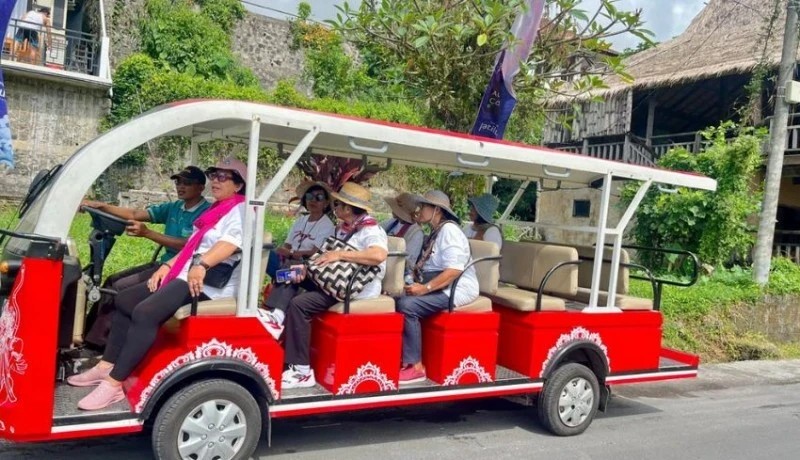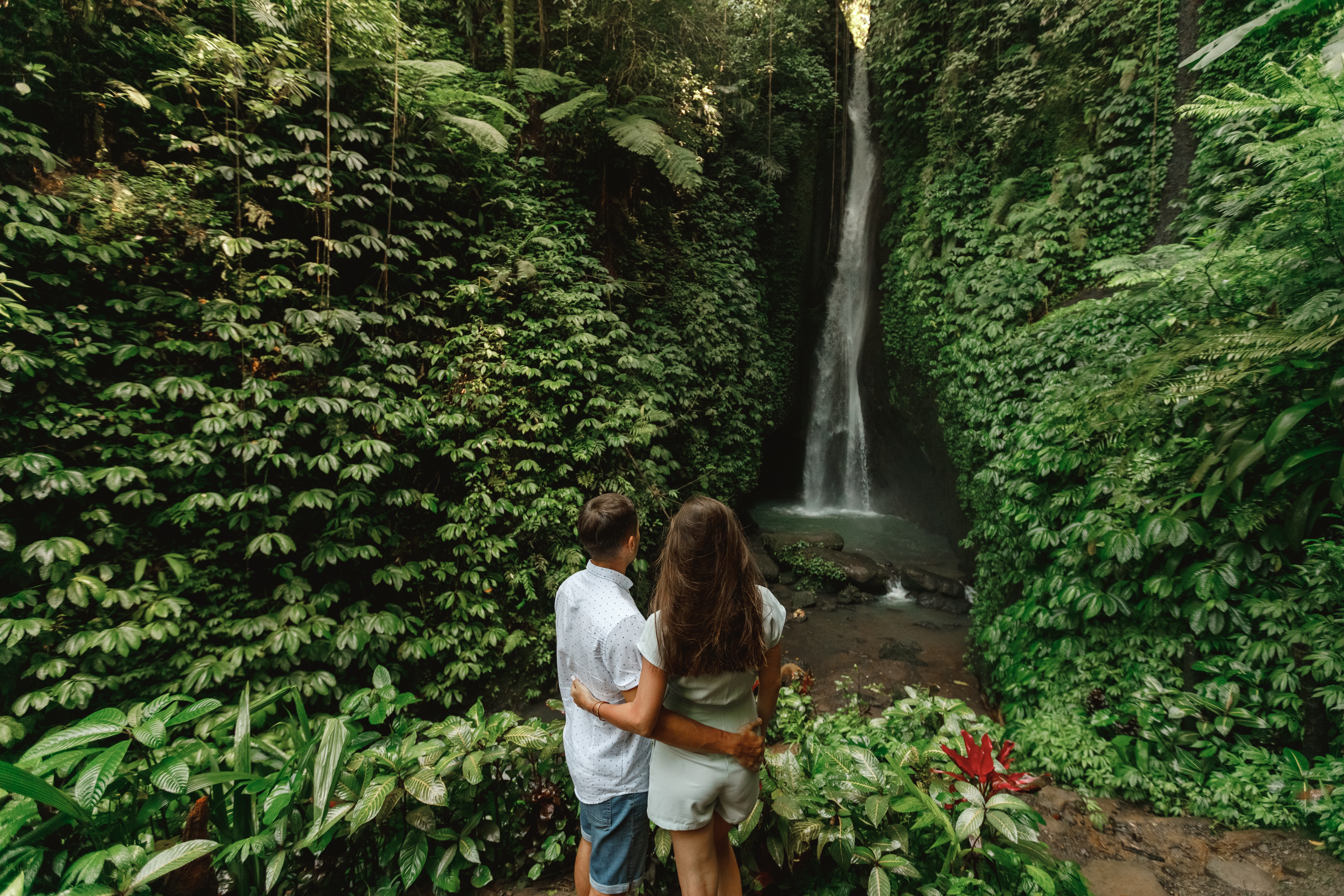Dreaming of a place where nature, culture, and a touch of magic come together as one? Welcome to Bali's rice terraces! Here, you'll witness the grandeur of Bali's nature. Indonesia's rice fields are a true natural wonder, their beauty is breathtaking, immersing you in a panoramic green fairy tale. What makes them so special?

The Uniqueness of Rice Fields
- Emerald cascades: Imagine a fairy-tale green staircase that seems to lead to the mountain peaks and clouds. That's how the rice terraces in Bali and Java look! These picturesque steps are just waiting to be photographed.
- Magical reflections: Here, rice and water become such close friends that they create something stunning. When water fills the fields, the sky and mountains reflect perfectly, transforming everything around into a mirror world, like a parallel universe. Streams flow, terraces shine, and all against the backdrop of majestic mountains and valleys.
- Palette of seasons: The rice fields change colors so quickly that even chameleons would be envious! In spring, they turn pine green, in summer they grow lush, and in autumn they shimmer with gold. It's as if nature constantly hits the 'refresh' button to update its Instagram feed.
- Echo of ancient traditions: Rice fields are not only a visual masterpiece but also a deep cultural symbol. Indonesians do not grow rice without reason — it's a whole philosophy! You can listen to stories about ancient rituals and omens for hours. And yes, locals here know the secret of the perfect rice.
Searching for the most beautiful rice terraces in Bali is almost like a treasure hunt, but instead of gold, you're greeted with magical green cascades of rice fields. This is where you should head to feel like a true seeker of beauty and great photos. Let's explore some of the most magnificent rice terraces.
Tegallalang – the Tourist Gem

Tegallalang in Ubud is the top tourist spot where the green rice terraces seem to pose diligently. Just 20 minutes from Ubud, and you're among enchanting terraces perfect for selfies amidst nature. Take photos and head to one of the local cafes with a view of the fields.
And if you find yourself on a swing above the terraces, don't forget to adjust the volume of your screams so as not to scare the neighbors! More on how to get there and other interesting sights in Tegallalang you'll find here.
Jatiluwih

For those who appreciate unique places, Jatiluwih in Tabanan, Bali is like a VIP room among rice terraces. This place is so impressive that UNESCO has even included it in the list of beautiful landmarks. It has all you need: farmers, fields, mountains, sunsets, and no crowds of tourists striving to take a thousand identical pictures.
Jatiluwih is located at an elevation where the mountain air is very fresh, and the lush green fields seem to weave into a picturesque carpet, creating the perfect backdrop for photographs. For a full view of Jatiluwih, watch the beautiful video and other information in this article.
Pupuan, Belimbing

The rice terraces of Belimbing in the Pupuan area are no less beautiful, where every slope is turned into the familiar picturesque steps, clearly outlined as if the rice fields are competing in neatness.
The Pupuan area covers 1877 hectares of rice fields that seem endless, making you think rice is grown here for the entire planet. Besides rice, this area is also famous for its coffee plantations, especially robusta production.
In the planting season, farmers weave the charm of traditional Balinese culture and traditions. They plow the land with buffalo, and during the harvest, they cut rice with sickles, standing in rows and singing songs. This process is accompanied by festivals where young people have the opportunity to communicate and meet. The beautiful Belimbing area is becoming an increasingly popular place to visit.
Here you can escape the crowds and city hustle, walk among rice fields and jungles, observe rural life, and feel the hospitality of farmers. After the rain, when fog descends upon the land, the village seemingly disappears in the clouds, adding magic to the landscape.
Location: Belimbing Rice Terrace.
Sidemen

If you wish to see rice terraces without jostling with other tourists, visit the tranquil Sidemen area. It's a quiet nook of eastern Bali where terraces seem to have been laid out by landscape designers using a ruler. And all this against the backdrop of Mount Agung, standing as a giant guardian of this paradise.
Sidemen Village is located two hours from Ubud. The journey along rural roads will not only offer walks through farmlands. Here you can enjoy trekking, stay at an eco-hotel, and purchase traditional souvenirs such as the woven songket and endek, known for their intricate patterns and vibrant cotton and silk threads. Souvenirs and paintings of rice fields will be great reminders of 'real' Bali.
Location: Sidemen Rice Terrace
Munduk Buleleng

Munduk is a picturesque mountain village in northern Bali, renowned for its natural beauty featuring waterfalls, rice fields, and lush green landscapes. Here you can engage in active pursuits like hiking and bird watching, and immerse yourself in local culture by visiting traditional Balinese villages and temples. Munduk is famous for its coffee and clove plantations, offering tours and tastings. Among the main attractions are the Munduk Waterfall and the twin lakes Buyan and Tamblingan, which draw many tourists.
Wide terraces, located just 2 km from the magnificent Munduk Waterfall, look enchanting and capture attention. Don't forget to visit the amazing Tamblingan Lake located east of the rice terraces for even more delightful travel memories!
Location: Munduk Rice Terraces.
Sesandan, Tabanan

Just 13 km west of Ubud are the hidden but truly charming Sesandan rice fields, nestled in the picturesque expanses of the Tabanan district. These terraces are in close proximity to Bali's amazing Butterfly Park.
Although the Sesandan rice fields are not as even as the famous Tegallalang terraces, the surrounding landscapes captivate with their beauty. The best time to visit is mornings or evenings when breathtaking views of the rice terraces unfold. Sunrises and sunsets here are truly impressive and just demand to be photographed.
Location: Sesandan Rice Terraces.
Soka Rice Terraces

There are also rice terraces, though not as popular, still worth attention. For instance, in the village of Soka, the rice fields are located close to the coast. They create a scenic backdrop with views of Mount Batukaru and are perfect for travelers exploring western Bali. On the way to Menjangan Island or Bali Barat National Park, Soka promises impressive panoramas and unforgettable views.
Location: Soka Rice Terraces.
Rendang

In eastern Bali, near the village of Sidemen, the Rendang rice fields are sure to captivate visitors with their natural beauty and craftsmanship. Stone temples and statues dot the landscape, preserving Bali's rich cultural heritage. Amid valleys filled with rice plantations and rushing water rapids, Rendang offers a tranquil retreat in Bali's countryside.
The area is dominated by rice fields, valleys, and rivers. The nature here is incredibly lush and beautiful. The convenient layout of these terraces helps local farmers channel water from one field to another, as water flows smoothly from high to low.
Location: Rendang Rice Terraces.
So, if you're planning an adventure to Bali's rice terraces, just choose any of these locations and head out for beauty, adventures, and a few hundred great photos for social networks! Yet, despite the development and expansion of rice fields, Bali's rice terraces face the threat of disappearing.
Bali's Rice Fields Threatened with Disappearance

In recent years, some scenic rice terraces are rapidly disappearing, turning into villas and hotels. The reason is that farmers, due to low income from rice farming, often cannot resist the temptation to sell their plots to developers, switching to more lucrative tourism activities. The development of tourist infrastructure leads to the construction of villas and hotels on farmland.
And now instead of 'golden fields,' tourists marvel at 'golden villas.' Farmers joke: we used to feed people with rice, now we serve them breakfast at the hotel. Nowadays, it's more common to see vast buildings among the rice fields. Massive villas and hotels for tourists quickly fill the territories, threatening Bali's unique landscape, which risks losing its authenticity and the island's green soul.
According to Chakra Widya, head of the Tri Hita Karana organization, visiting rice terraces is a must for most tourists coming to Bali. However, the growing number of tourists necessitates infrastructure development, which leads to the construction of real estate. Saving Bali's rice terraces is possible, but it will require serious efforts and joint actions by local authorities, farmers, and society.
Here are some ways that might help:
Eco-tourism: Organize tours around the terraces, where tourists can learn about traditional rice farming, participate in the planting or harvest process. This will help preserve the fields and provide income to farmers without selling the land.
Financial support for farmers: The government or local authorities can subsidize farmers to keep rice cultivation a profitable endeavor. This would reduce the pressure to sell land for development.
Legal land protection: Implement laws restricting the development of farmland and preserving key areas for agriculture.
Promoting local products: Supporting interest in local products like Balinese rice could create demand and raise product prices, making farming more profitable.
Thus, if we properly combine the interests of farmers and tourism, we can not only preserve rice terraces but also make them an important part of Bali's future.
Sources: Jatiluwih.id, indonesia.travel/jp



If you really want to see greenery everywhere you look, with rice swaying in the wind and water murmuring in the irrigation channel, then head to Jatiluwih. I can't recommend the cafes, but the views of the terraces are definitely the best there.